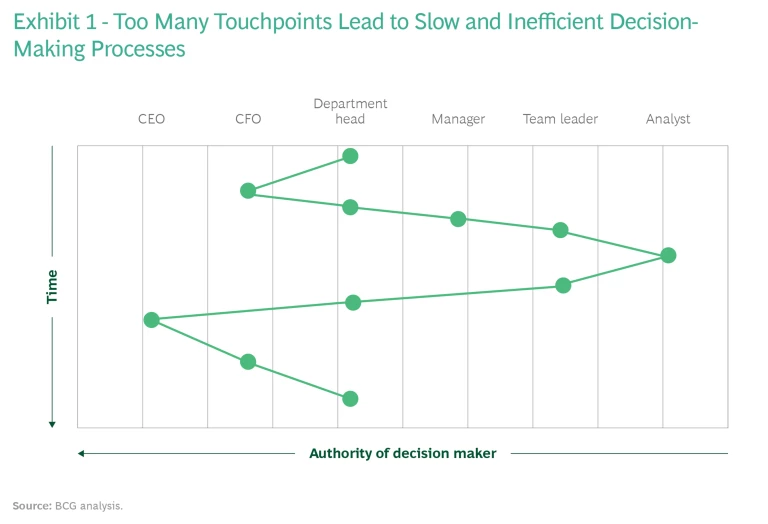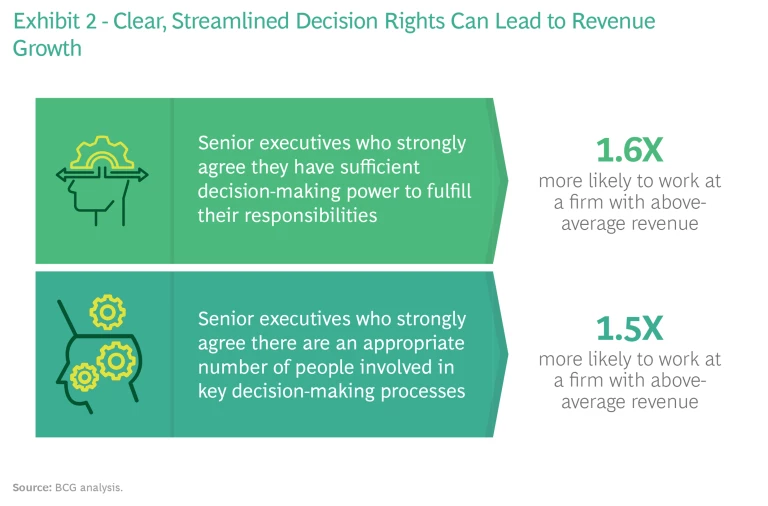Every day, organizations need to make decisions—from how to accomplish strategic objectives, acquire goods and services, launch (or discontinue) projects, and grow their people, to how to pursue organizational transformation . Having a rigorous, clear framework for defining who owns, vetoes, influences, and supports these important decisions can go a long way toward helping organizations operate rapidly and effectively.
Whatever their goals, private enterprises and government agencies alike face unrelenting pressure to make timely choices. For private-sector firms, rapid decision making is crucial to meeting customers’ expectations, responding quickly to competitive pressures, and adjusting to evolving market dynamics. In the public sector , leaders need to be able to quickly respond to shifting priorities and emerging crises. Delays can hinder the implementation of policies and even deprive constituents of vital services.
Yet many organizations struggle to make quick decisions—and even more fail to implement the choices they make. Often, decision making is slowed down by complex, multilayered organizational structures where decisions must bounce back and forth across multiple levels, hitting numerous touch points before gaining approval. (See Exhibit 1.)
Another issue is a lack of clarity around who is actually responsible for making decisions. The organizational factors that contribute to indecisive and delayed decision making are often compounded by risk-averse cultures where employees feel they must get “top level” sign off for even low-risk activities. Some organizations also struggle with lengthy data calls that require week-long hunts for the appropriate data before an informed decision can be made.
All these problems are broadly known to slow down an organization’s decision making, but there is another crucial factor that is often overlooked—transparent decision rights. “Decision rights” are an open agreement regarding who gets to make what decisions, who contributes to the decision-making process, and in what capacity. In many organizations, these rights are unclear or contested, which means that decisions are delayed while leaders navigate complex processes to determine who has decision-making authority. Murky decision rights not only waste leaders’ time but also undermine confidence in whatever decision is finally reached.
Murky decision rights not only waste leaders’ time but also undermine confidence in whatever decision is finally reached.
As a result of decades of experience advising clients on developing more agile and responsive organizational structures, BCG developed the OVIS framework. The framework establishes and supports transparent decision rights, resulting in faster decision-making speed—which ultimately helps organizations meet their strategic objectives, such as hitting revenue targets or completing organizational transformations in a timely manner. Implemented properly, with active dialogue and review to ensure buy-in, OVIS can facilitate understanding throughout the organization of the various roles in the decision-making process.
More Transparency, Clearer Accountability
To improve the transparency around decision rights, organizations must start by answering these three questions:
- What are the crucial decisions that need to be made?
- Who should be involved in each of these decisions?
- How should individuals contribute to the decisions?
Once organizations answer the first two questions around high-priority decisions and key stakeholders, OVIS assists in solving the “how” part of the equation. OVIS stands for “Own, Veto, Influence, Support.” Under OVIS, each stakeholder is assigned one of these four decision-support roles:
- Owner. Owners, in this framework, are those who have the final authority and are accountable for the impact and efficacy of their decisions. In addition to the final decision rights, they are charged with the responsibility of managing an inclusive decision process that involves all other relevant stakeholders.
Decision owners are expected to actively resolve disagreements and accommodate concerns, where possible, to create a more thoughtful outcome and build institutional buy-in and support for any implementation. The role of the owner is to balance input with speed—making sure to include critically impacted stakeholders in the process before ultimately making the decision at hand.
- Veto Holder. Veto holders can block owners’ decisions but are advised to exercise that power sparingly. Veto holders should work to resolve their concerns with the owners during the decision process. If decision owners and veto holders cannot reach agreement, veto holders can escalate concerns to a superior.
To ensure processes aren’t slowed unnecessarily, there should be very few veto holders—ideally no more than one per decision. For many decisions, there may be no veto holders at all. Veto holders should only include those whose legal or managerial responsibilities are directly impacted by the decision. They are expected to negotiate in good faith before escalating disagreements to superiors; indeed, any such escalation should be vetted for such good-faith negotiation before superiors agree to intervene.
- Influencer. Influencers typically are responsible for implementing the decisions that owners make, or they have unique expertise that owners need in order to make good decisions. Owners should create opportunities for influencers to contribute opinions or information related to the decision, and to communicate any objections or concerns about how the decision will impact their area of expertise.
Unlike veto holders, influencers do not have the power to escalate decisions to superiors. That said, owners are still expected to take influencer input into account and try to resolve any disagreements.
- Supporter. Supporters provide required information to make decisions but are not necessarily included in the decision process. Decision owners need reliable information to make sound decisions, in the form of data or expertise. Identifying these supporters—and ensuring they understand their obligation to share timely information proactively—will help to speed the decision process.
While owners rely on the information they receive from supporters, they are not required to solicit supporters’ perspectives on the overall decision and are not obligated resolve any objections that supporters might have. This distinguishes the support role from the veto holder and influencer roles.
The OVIS Advantage
Although companies often clarify decision rights as part of a larger restructuring or organizational design effort, the OVIS tool can be implemented independently to deliver value immediately. By upgrading the clarity and transparency around decision rights, OVIS yields four key benefits:
- Faster decision making. With greater agility, organizations are better able to seize opportunities and defuse crises.
- Less wasted time. By limiting decision-making processes to essential stakeholders and preventing excessive escalations, OVIS saves senior employees from attending unnecessary meetings and reduces demands on their valuable time.
- A culture of greater accountability. By boosting clarity around how decisions are made and delegated, OVIS can help create an overall culture of accountability for both big and small decisions, while building institutional capacity for decision making.
- Empowered, engaged employees. Empowering individuals to make decisions supports personnel growth and leadership development, which can lead to greater employee engagement.
While isolating the impact of decision rights alone in an overall transformation can be difficult, a recent BCG global survey of private-sector senior executives found a strong correlation between clear decision rights, streamlined decision-making processes, and above-average revenue growth. (See Exhibit 2.)
OVIS in Action: Reforming Decision Rights to Support a Business Model Transformation
A major US media company needed to reform its decision rights process to support its transformation to a digital-first business model. The organization demonstrated early traction with digital products but faced several problems completing the transformation of its business model—including challenges related to advertising and profitability, friction between departments accustomed to operating in silos, and slow execution. These issues left employees frustrated with the difficulties of getting things done.
BCG diagnosed the organization’s pain points, evaluated successful external models, and examined the organization’s structure to improve the decision rights structure for a key set of high-priority decision points, including how to set digital subscription and overall targets, how to define audience segments, and how to sequence and prioritize product and technology roadmaps.
In keeping with OVIS principles, the organization limited ownership of these decisions to a single individual or body, while allocating veto power to just a few people. By effectively delegating decision rights, the company eliminated the tendency to escalate decisions to numerous executives.
OVIS helped “unstick” the organization and facilitated a dramatic increase in decision-making efficiency. This, in turn, enabled the organization to fully execute its digital transformation.
While too many reorganizations fail to achieve their desired results, OVIS played a key role in ensuring that this digital transformation was a resounding success. The organization accelerated its decision-making speeds and clarified cross-functional processes, while improving its ability to establish and track goals and metrics and adjust reporting lines. The overall effort resulted in quantifiable operational efficiencies, including a 15% cost savings in technology, 10% savings across the finance function, and 5% savings within marketing activities. (Find out more about how OVIS can help media companies execute successful digital transformations .)
OVIS Supports Other Organizational Tools
Organizations can use OVIS effectively alongside established role and accountability frameworks such as RACI (Responsible, Accountable, Consulted, Informed), which assigns responsibility for certain tasks within a process. OVIS, on the other hand, focuses on specific crucial decisions and is more targeted to the areas where organizations often see bottlenecks.
OVIS also works seamlessly with other important organizational tools including role charters, within which decision rights deserve equal weight alongside other key elements such as accountabilities, leadership behaviors, and success parameters. Specifically, role charters should include a decision rights component and specify which decisions a person in a given role owns, influences, supports, and vetoes.
A Framework for Success
Establishing clear decision rights can bring tangible and immediate benefits to any organization by driving improved efficiency and greater progress toward strategic objectives. When paired with other tools such as role charters, OVIS can facilitate clear and sustainable improvements for organizational performance. However, whether employing the OVIS framework as part of a broad transformation, complemented by other tools, or targeting it to a specific organizational pain point, having transparent ownership of specific decisions will enable faster decision making, reduce time wasted in meetings, and support accountability and growth of employees.














